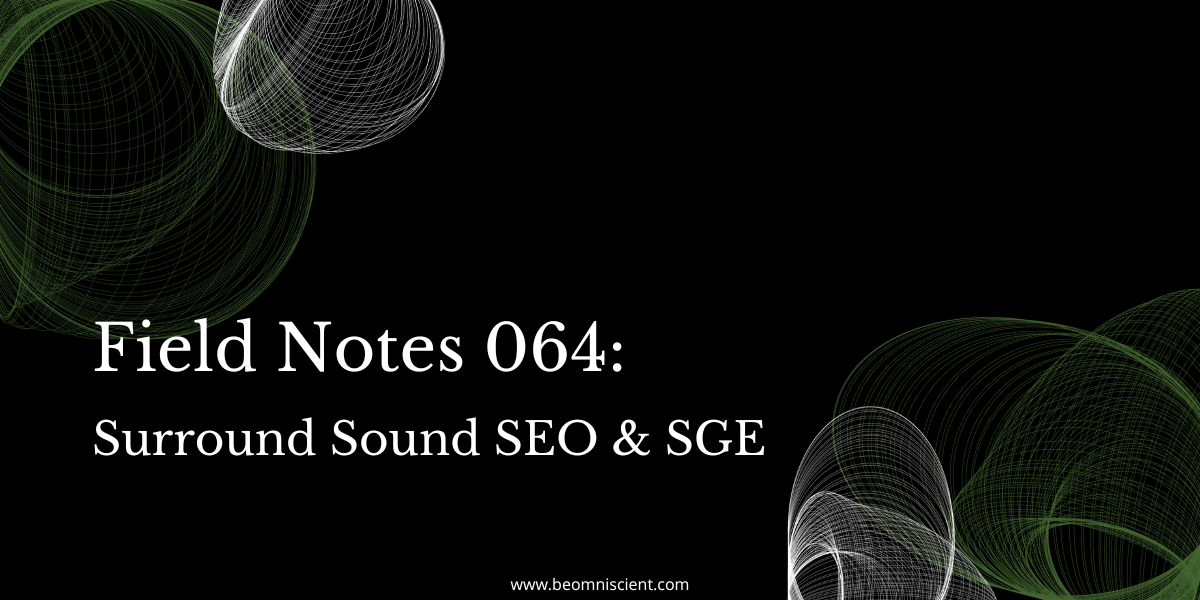
The ultimate aspiration of a mature marketing program is categorical ubiquity—to become the obvious option, a synecdoche representing all other options.
Before reaching this peak, however, a brand must first enter the conversation.
In SEO, we typically aim to rank our own pages for high-value keywords. This brings qualified traffic, and once visitors click through to our websites, we hope to convert them into an owned audience member or a product user.
What is Surround Sound SEO? Background and Explanation
While working on user acquisition growth at HubSpot, I stumbled upon an interesting iteration of traditional SEO.
First, I noticed that certain content formats converted an order of magnitude higher than the rest (think “best [keyword] software”). Next, I noticed that HubSpot received a lot of traffic that also converted very well from other websites that included us on their “best X” lists.
Coupling that with common advertising wisdom, including the mere-exposure effect, we came up with the Surround Sound SEO strategy.
Surround Sound SEO seeks to monopolize the search engine results page for a high intent query. Instead of ranking one page, the goal is to be favorably mentioned on every single page, creating a surround sound effect.
Take, for example, the keyword “best content marketing podcasts.” This very likely represents an exploratory search, someone looking for a bunch of recommendations for new podcasts to try out.
It’s like someone asking for a recommendation from a group of trusted friends at a proverbial cocktail party.
If one person mentions a given product, you might check it out.
But what if everyone recommends a product?
The likelihood you check out that product goes up immensely, especially if truly trusted sources recommend it.
That’s the gist of the Surround Sound Strategy. It’s a complex intertwining of SEO, content marketing, product marketing, brand marketing, and digital PR.
Even ignoring keyword difficulty, search volume, etc. you can see from a common sense perspective that having trusted sources recommend you, everywhere, is a good thing.
Now, let’s consider how this plays into a world increasingly influenced by generative AI.
Surround Sound SEO, Generative AI, and Next Moves
Much of this section involves conjecture, but just to get this out of the way: Surround Sound SEO already influences your inclusion in Google’s featured snippets:
The inclusion here seems to be fairly straightforward: scraping top results for the search query, finding commonalities, and surfacing these commonalities.
Now, Google SGE is experimental (as they clearly state):
We don’t know, necessarily, what data points they’re using to form AI summaries and answers, nor how these data points are weighted or communicated.
However, the data has to come from somewhere, and it’s very likely that inclusion in the AI-powered overview will also depend on ubiquity on search results related to the query as well as the weighted importance of the source (note, again, this is conjecture on my part).
We can assume, also, that AI-powered overviews will become better and more accurate over time, an increasingly common starting point of the search journey.
However, unlike the Surround Sound SEO we ran at HubSpot, which one could “hack” somewhat easily using tactics like parasite SEO, high velocity link building, and content partnerships, I’m betting that AI-powered answers will have a higher barrier to entry.
Essentially, SEO in and of itself will be necessary but no longer sufficient. How your brand is spoken about in the news (PR and Digital PR), how you’re categorized on review sites and the quantity and quality of your reviews (customer marketing), how you’re spoken about naturally on social media and forums like Reddit (social media, community), and even your owned entities like the messaging on your website (product marketing and brand) will likely play a factor.
Again, all of this is speculative, but it’s based on my past efforts scaling Surround Sound SEO at HubSpot (as well as with a handful of clients) and also reflects early experiments we’re working on at Omniscient optimizing for AI-powered answers:
But this should be good news to many: all of the above is hard to fake. It means the future of SEO is less likely to lean on “check the box” activities like stuffing a certain density of “LSI keywords” into a blog post or building 12 links per month, and it will lean more on meaningful business activities like:
- Forming strong internal partnerships with product marketing, brand and PR teams.
- Using search not only as a traffic and conversion channel, but as a parlay into building an owned audience.
- Focusing less on optimizing for the median value (the average of the top 10 search results), and more on information gain (what do YOU add to the conversation?)
I’m excited about the future of SEO, and I’d love to talk to anyone interested in Surround Sound SEO campaigns, how to future proof your content marketing strategy, or how to plan for changes in search behavior. Just respond to this email 🙂
Want more insights like this? Connect with me on LinkedIn.
Recommended Reads
- Kitchen Side: Surround Sound SEO & Optimizing for Generative Answers – David and I did a recent podcast covering Surround Sound SEO in detail, including tactics we’ve used.
- How to Boost Your Search Visibility with a Surround Sound Strategy – my former colleague, Irina Nica, really scaled the Surround Sound Strategy at HubSpot. Listen to her talk about it in this webinar.
- How generative AI will change SEO as a profession – takes from Britney Muller and Dave Davies on how generative AI may change the SEO function. Again, all speculative, but IMO some great takes.



